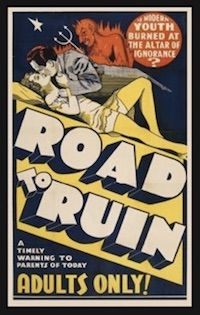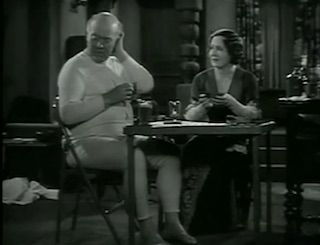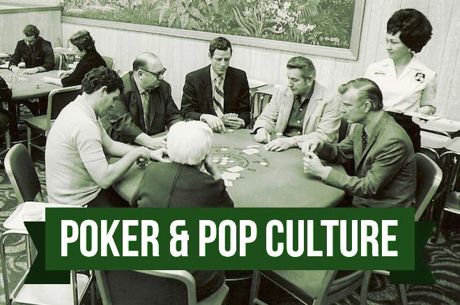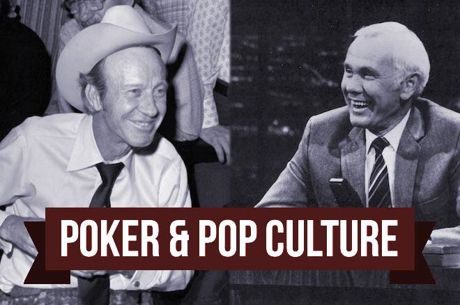Poker & Pop Culture: A Sneak Peek at Strip Poker

The origins of strip poker �� that racy variant in which players wager items of clothing rather than chips or money �� is as hard to pinpoint as the beginnings of poker, generally speaking. However, most accounts suggest the idea of taking it off while taking a card probably first occurred not long after the game was introduced in early 19th-century America.
Just as New Orleans is often identified as a starting point for poker in the United States, there, too, have some speculated the first strip poker games took place. Others have located the game in 19th-century brothels, introduced as a way to enliven even further the usual negotiations occurring in such establishments.
In American popular culture, references to strip poker can be found in cinema dating back to the silent era. One of the more famous (or infamous) examples comes in the 1928 silent film The Road to Ruin starring Helen Foster as the wayward youth, Sally Canfield.
Blurring the line between "educational" and "exploitative," the film was highly controversial in its day, banned in several U.S. cities yet apparently shown in high schools as a stern warning against delinquency's dire consequences. It was also one of the top grossing films of the year, earning a not insignificant $2.5 million at the box office.

From the start, sweet Sally, her neglectful parents having failed to provide her proper guidance, falls in with the "wrong crowd" and swiftly slips into a downward spiral. Before her sad story concludes, it will involve smoking, drinking, drug use, premarital sex, prostitution and abortion.
Among these salacious subjects occurs a game of strip poker at a party, here clearly serving as further evidence of Sally's moral decline. The pre-Hays Code sequence reportedly featured nudity, too, thus prompting some exhibitors' objections, although surviving prints feature an awkward jump cut which appears to have excised the offending images.
Remade as a talkie in 1934, The Road to Ruin again starred Foster (with a different name), in a relatively less tawdry version of the same story, though still plenty controversial by the day's standards. Among the several mostly incidental changes to the story, the partygoers play dice rather than poker as they gamble away their garments.
Other strip poker scenes pop up in '30s and '40s films, such as in the 1932 political satire The Dark Horse starring Bette Davis. That one begins with a party randomly choosing a woefully unqualified gubernatorial candidate, then finds his campaign manager struggling throughout to keep the candidate in line.
On the eve of the election the rival party comes up with a plan �� an "ace in the hole," they call it �� to employ the campaign manager's ex-wife to lure the candidate to a remote mountain cabin for a game of strip poker. Out comes the deck of cards. And soon, the long underwear.
The low-budgeted melodrama Mad Youth (1940) �� a.k.a. Girls of the Underworld �� also features strip poker being played by a group of teens while their parents are away having their bridge club, with some clever cross-cutting between the two card games affording a few grins.
We hear a mother commenting at the bridge game over her cards about her dutiful daughter. "Thank goodness I don't have to worry about my Beth," she says at one point, calling her a "model youngster." Back to the poker game, where Beth is removing her top. "She's such a modest little mouse," adds Mom later. Jump cut back to Beth, now wearing the tablecloth!
Strip poker became increasingly popular in America during the 1950s and 1960s, appearing in popular culture with increasing frequency �� along with other formerly forbidden fare �� as the nation embarked upon what would come to be called a "sexual revolution."
The image up top is the title screen from A Sneak Peek at Strip Poker (1966), a six-minute short directed by sexploitation pioneer Joseph Sarno. Much tamer than Sarno's feature work �� and fairly tedious, too �� the film perhaps functions as a kind of "how-to" demonstration for the curious.
Before directing One Flew Over the Cuckoo's Nest, Amadeus and other acclaimed features, Czech director Milos Forman's 1971 comedy Taking Off comments on the period's cultural shifts while also incorporating strip poker into the story.

After their teenaged daughter runs away from home, Larry and Lynn Tyne meet up with other parents of runaways, eventually becoming encouraged by them to enjoy the newfound freedom they've been afforded. The story becomes increasingly farcical (and funny), with the middle-class types becoming introduced to various vices.
Eventually the Tynes and another couple find themselves at the end of an enjoyable evening �� drunk, stoned and playing a card game called "Texas one-card showdown." In the game, each player draws a single card, with the one drawing the lowest having to remove an article of clothing.
The game progresses �� providing a kind of literal reference to the film's title �� with Larry ultimately the big loser. He delivers a rambunctious song in the nude, the performance having the others in stitches, when his singing is interrupted by the surprise return of their daughter. Awkward!
Further evidence of strip poker's popularity around this time is provided by the 1972 publication of Playboy's Book of Games which includes a detailed section describing the rules and game play.
"This exciting game, though very popular in some circles, is rarely if ever discussed in card books," writes author and noted gambling expert Edwin Silberstang. He goes on to present the game as a great way "to break the ice" at social gatherings.
Only "bona-fide articles of clothing" can be wagered, he insists, thereby excluding band-aids, eyeglasses, jewelry and false noses. Further recommendations include playing draw poker rather than stud, since the latter game will likely result in players running out of clothes too quickly.
Strip poker's popularity faded somewhat thereafter, although if references in popular culture are an indicator, the game remains firmly in the public's collective consciousness.
In the early 1980s, among the first games created for home computers were forms of strip poker, with players rewarded with static, monochrome images for winning hands �� both crude and crudely-rendered. Such games have progressed with the times, of course, and continue to be played today.
There was a short-lived game show called Strip Poker on the USA Network (in 2000-01). Unsurprisingly, Lady Gaga and her supporting cast play the game in her 2008 video "Poker Face." The American Pie franchise has alluded to the game more than once.
In the opening of The Social Network (2010) we see Harvard student Mark Zuckerberg busily creating and launching his "Facemash" site (a Facebook prototype) while students across campus party it up, with strip poker among their chosen activities.
And in 2011 some performance art in New York City got some attention, one involving 48 people rotating in and out of an ongoing game of strip poker in a studio's front window.
In an explanation of the piece's intentions, artist Zefrey Throwell described "strip poker as a metaphor for the economy, with clothing symbolizing money," adding that "while skill can help, the people who show up with the least clothing are in the worst shape, and no one can control the luck of the draw."

Speaking of metaphors, Anthony Holden once famously observed that "whether he likes it or not, a man's character is stripped bare at the poker table." Holden's point was to emphasize the inescapability of "exposing" oneself (figuratively) at the poker table, as well as the need to appreciate that fact if one hopes to endure as a player.
"Unless he is both able and prepared to see himself as others do, flaws and all," writes Holden, "he will be a loser in cards as in life."
You could say that strip poker makes literal this process of being "stripped bare." However, in the case of strip poker, the good players �� or the lucky ones �� are able to avoid the "showdown."
From the forthcoming "Poker & Pop Culture: Telling the Story of America's Favorite Card Game." Martin Harris teaches a course in "Poker in American Film and Culture" in the American Studies program at UNC-Charlotte.









